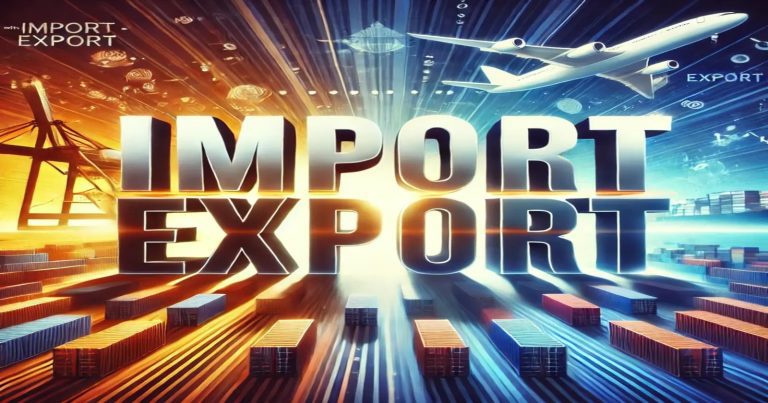The word import export is the foundation of international trade and commerce. It is importing goods and services from another country (import) and exporting goods and/or services to another country (export). All this system has achieved is linking countries economically, politically and socially to trade resources, technology, and goods to support their development.
Imports are the import of goods and services into a country to meet demand, whereas exports are the export of surplus products to markets across the world and the realization of complex foreign exchange.
Not only is understanding import export relevant for companies who intend to take a step into international trade, but it also provides a window into, and helps to unravel other aspects of global economic movements. In this article, we’ll explore the import and export business in detail, learn how to start, and discuss the essentials of succeeding in international trade.
Import Export
Import export involves various activities, ranging from sourcing products to delivering them to the final consumer. Importing is a mechanism that allows firms to introduce goods and services that can’t be produced locally to the domestic market, and exporting generates more sales revenues and profits by extending beyond the domestic language barriers.
At present, digital tools and technologies have ensured that imports and exports are becoming cheaper. Internet portals link buyers and sellers worldwide, and even small businesses can use them to trade internationally. Companies need knowledge of trade policies, such as tariffs, customs duties, and international treaties, in order to do business effectively.
Import and Export Business
The import and export trade offers an avenue for entrepreneurship to partake in international trade and increase wealth. It involves buying products from one country and selling them in another. This industry goes from small-scale businesses to big multinational companies with bulk goods. The options, that is, the products you select and the markets you serve, are limitless.
Why is the Import and Export Business Profitable?
The import export trade has great promise and is facilitated by the increasing demand for export products and services. Consumers are increasingly desiring variety and quality, and enterprises rely on foreign goods to source raw materials, parts, or finished products. Exporting, on the other hand, allows companies to earn foreign currency and reduce overdependence on local markets.
Companies entering the import and export business need to choose the right product. Items with high demand, a low number of competitors and, stable supply chains for international trade are uppermost. Not only does the discovery of new market trends assist businesses in gaining an advantage, but it can as well.
How to Start an Import and Export Business?
Study the law of international trade in your country. For example, most countries require an import-export license. For this license, your company is technically authorized to conduct global trade business under the act.
- Market Research: Observe both home and foreign markets. Understand consumer preferences, demand patterns, and pricing trends. This can be used to determine the right product and right target group.
- Building Partnerships: Developing contacts with reliable suppliers and buyers. All of this can be achieved by attending trade exhibitions, contacting exporters/importers, or registering online.
- Managing Logistics: Secure tie-ups with logistics companies to enable hassle-free delivery and transportation of the goods. Prompt delivery is imperative to maintaining trust with the customer.
- Compliance: Keep abreast of the tax laws, tariffs, and trade treaties of the countries you are dealing with. Non-compliance will result in huge fines and delays.
How to Import?
Import is the process of buying goods or services produced outside of your country and importing them to your home country. The process begins with identifying a product that your domestic market demands but cannot produce efficiently. After identification, companies look for international sources, i.e., suppliers or manufacturers, to produce the product. Negotiation of pricing, quality, and shipping conditions is also crucial at this point. Companies also have to make sure they comply with the customs rules and taxes of the exporting and importing countries.
For instance, if a company in India attempts to import electronics from China, it must adhere to Indian customs rules, pay applicable duties, and fulfil the necessary documentation. Firms also have to collaborate with carriers to deliver goods safely.
Steps to Import Successfully
- Choose a product with high local market demand.
- Look for reliable foreign vendors via trade directories or online channels.
- Negotiate contracts regarding product quality, delivery deadlines, and pricing.
- Acquire the required documents, such as an import export license, to proceed.
- Collaborate with customs brokers to optimize port clearance rates.
- The import capability of a company can be used to bring in new ideas for a product and produce at a low cost. However, the process requires thorough research and efficient execution.
How to Export?
Exporting involves selling locally produced goods or services to customers in foreign countries. It is beneficial to enterprises to enhance as well as new sales opportunities, to broaden the income portfolio and to become a worldwide brand. Exporting is a great way for firms to expand by going to markets outside their country.
Companies need international markets where to sell their products when exporting. In this process, market research is used to define target audiences, competitors and regulatory constraints in the target country. Businesses must subsequently connect with distributors, retailers or end users in these markets.
For instance, a company exporting textiles from India to Europe would have to comply with European quality standards, labelling regulations, and shipping schedules. All customs documentation and tariffs must be processed correctly to achieve success.
Steps for Successful Exporting
- Identify products with demand in foreign markets.
- Partner with international buyers or distributors.
- Obtain export permits and comply with trade regulations.
- Arrange transportation and packaging in such a way as to allow the product to arrive in good condition at the delivery destination.
- Leverage secure payment instruments such as letters of credit to guarantee financial reliability.
- Exporting opens up new opportunities for businesses to expand and enables nations to fuel their economies through foreign exchange further.
Essentials of Import and Export
A successful import and export business relies on careful control over several factors. Such elements include legal compliance, logistics management, financial planning, and market research. Companies may take detours, suffer fines, and even face financial pitfalls without these.
- Import Export License: This is the first step for all of those who want to trade across borders. Companies could not perform import and export activities without such a legal paper.
- Product Knowledge: Companies need to have proper knowledge of the products they are dealing in, including quality parameters, sourcing expenses, and their profit margins.
- Customs Regulations: Every country has its own rules for entry and exit of merchandise. Businesses should know their entry and exit rules to prevent shipment penalties or delays.
- Effective Logistics: In every import export operation, transport and delivery are paramount. Reliable partners in delivery ensure that their products reach their destination on time and intact.
- Market Trends: Industry consideration of the trend of changing consumers’ attitudes and the market will is the way to sustain the competition.
Import and Export Difference
Although import and export are synonyms of international trade, they have different procedures and aims. Importing refers to expanding imports to satisfy domestic demand, while exporting refers to selling domestic goods abroad.
| Aspect | Import | Export |
| Definition | Bringing goods into a country from abroad. | Sending goods from one country to another. |
| Objective | Meet local demand for foreign goods. | Supply domestic goods to global markets. |
| Revenue Generation | Generates costs for the economy. | Brings foreign exchange into the economy. |
| Regulations | Focuses on compliance with import rules. | Emphasizes adherence to export regulations. |
Import Export FAQs
What is the meaning of import export?
Import export is buying products from foreign markets (import) and selling national products from abroad (export).
How can I start an import and export business?
In order to launch an import/export business, it’s crucial to do market research, get an import/export license, identify and select trustworthy suppliers/buyers, and administer logistics successfully.
What is an import export license?
An import export license is an authorization piece that gives companies the right to trade across borders.
What does the export import bank of India do?
The export import bank of India assists Indian enterprises through financial support, loans, and assistance for export-import businesses.
What are the main differences between import and export?
Imports are shipments into a country, and exports are shipments from a country. Imports supply the internal demand, and exports generate income through overseas markets.


